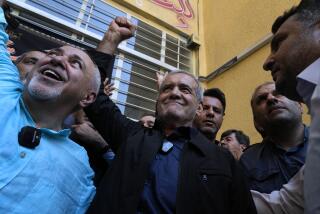From new media, a new portrait of Iran emerges
NEW YORK â By the time Iranian authorities drew the curtain this week, it was too late.
Attempts to choke off coverage of massive protests and postelection street battles between dissidents and government forces came well after the American public had reset a nascent and evolving impression of Iran, experts say.
With the cooperation of the government, the global media buzzed in the days before the June 12 election with images of a youthful and exuberant Iran engaged in political debate. Even âThe Daily Showâ was allowed to profile a lovable, not-unlike-us Iranian family.
It was a far cry from footage from decades ago of fanatics raging against America, more recent focus on Iranâs nuclear program, or reports of President Mahmoud Ahmadinejadâs frequent America-bashing as he traveled the world.
That wonât be true again, predicts James Rubin, a former U.S. assistant secretary of State for public affairs. âWhether itâs in the Arab world or developing world, or even in Los Angeles, the perception of Iran is forever changed as a result of whatâs happened.â
No amount of censorship can eradicate the image of a divided Iran torn by internecine power struggles. Or of a dispute spilling out onto the streets where cosmopolitan-looking young men and women raged at authority.
âThey havenât shut down the Internet yet and they wonât,â Rubin said. âItâs a step too far, because they need it for business and other reasons.â
First, Iran restricted Western journalists from reporting on the demonstrations, then forced many to leave when their visas expired.
Some foreign reporters were arrested. Officials on Tuesday confirmed the arrest of a reporter working for the Washington Times, Iason Athanasiadis.
The government was able to slow the ability of the mainstream news media to tell the story; by Sunday many news organizations had trouble finding fresh photos and video, and reran old images in a constant loop.
But that didnât shut down the story, because thousands of Iranians, armed with cellphones and video cameras, were providing new material.
âWhat the Iranian leadership didnât seem to understand, as they went through the traditional methods of censorship, is that everybody is now a reporter,â said Jeffrey Cole, director of the Center for the Digital Future at the USC Annenberg School for Communication.
He acknowledged that that raises questions of accuracy because âeverybody doesnât go to journalism school or adhere to professional standards, but literally everybody can use a cellphone or a camera or sound equipment, and the information canât be stopped.â
The Iranian government managed to throttle down many websites and cellphone and broadband services.
âBut,â Cole said, âa lot of this has to come back eventually, and when it does, all the texting and video that couldnât get out, will get out.â
Most of those images, however, have been provided by protesters and other supporters of change. If the outside world relies primarily on electronically transmitted text messages and videos, it runs the risk of underestimating Ahmadinejadâs support among his core backers, who tend to be poorer and more rural and are less likely to use the tools of social media.
CBS News Foreign Editor Ingrid Ciprian-Matthews said that although the networkâs correspondent in Iran, Elizabeth Palmer, was forced to leave this week, the âEvening Newsâ continued airing fresh images gleaned from the Web.
âWe have a whole mechanism weâve set up in New York and London with Farsi-speaking reporters trolling websites and blogs for information,â she said. âWe just have to work extra hard to verify what weâre getting.â
Concerned about the safety of CBS contacts still in the country, she was reluctant to discuss how the network would continue covering the showdown. But she was clear that âwe continue to try.â
That reliance on social media suggests that the outside world may once more be getting less than a full view of Iran, this time told through the prism of government opponents.
Aaron Brown, formerly CNNâs anchor and now a journalism professor at Arizona State University, said many American news outlets would continue to chase the story of Iranâs political future, even if the moderate candidate, Mir-Hossein Mousavi, doesnât prove to be a great democratic leader. Mousavi, a former Iranian prime minister, claims that Ahmadinejad won reelection through fraud.
âHeâs not Thomas Jefferson, the way Americans would like to think he is,â Brown said. âThe situation is way more subtle than that. But it is a great story -- with a bad guy, a not-so-clear good guy, dramatic pictures and a sense of David and Goliath.â
And even if the government in Tehran successfully squelches 90% of the coverage out of Iran in the coming months, Brown predicted, one compelling image will have a long life span -- Neda Agha-Soltan bleeding to death on a street in Tehran.
âIt only takes one image,â he says. âAnd that one is hard to replace.â
--
More to Read
Sign up for Essential California
The most important California stories and recommendations in your inbox every morning.
You may occasionally receive promotional content from the Los Angeles Times.










